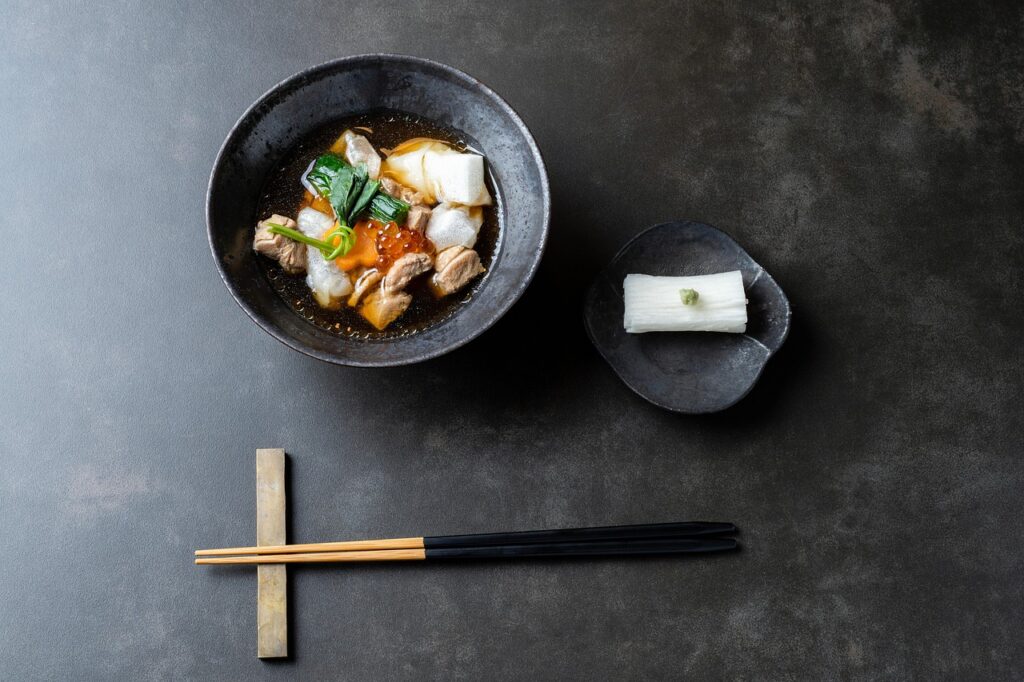
Leaving Washoku Names in Japanese
-Why We Don’t Translate “Sushi” into “Vinegared Rice with Raw Fish” –
Washoku, or traditional Japanese cuisine, is beloved around the world.
Names like Sushi, Tempura, Ramen, and Sake have already crossed borders and are now used almost like international words.
But here is something important: we should keep the names of Washoku in Japanese, without translation.
It feels natural to write “寿司 = Sushi,” but the moment we call it “vinegared rice with raw fish,” something essential is lost.
So why is it so important to preserve these names in their original Japanese form?
1. Nuances Lost in Translation
Words carry more than just meaning—they hold culture, history, and a way of feeling.
-
Sushi
If translated as “vinegared rice with raw fish,” it risks being misunderstood as nothing more than “raw fish + rice.”
But sushi includes many varieties: nigiri, maki, oshi, chirashi… It cannot be explained by “raw fish” alone. -
Miso
Often translated as “fermented soybean paste,” yet it also involves rice or barley koji, with many regional styles—red, white, blended.
For Japanese people, miso is not just a seasoning but a foundation of daily health and life.
Translation is convenient, but it often cuts away the diversity and context embedded in the word.
2. Names as Cultural Brands
Food names are not mere labels—they are brands of culture.
-
We don’t call Kimchi “fermented spicy cabbage.”
-
We don’t call Paella “Spanish mixed rice dish.”
The pride and cultural meaning vanish if we do.
The same is true for Washoku.
Sushi and Sake are cultural brands that embody Japan.
If translated, their cultural weight and brand value are diminished.
3. Japanese Names Spark Learning
When kept in Japanese, food names inspire curiosity and provide an opportunity to learn.
-
Onigiri is not just a “rice ball,” but a symbol of Japanese everyday life.
-
Dashi is more than “broth”—it carries the philosophy of umami from kombu and katsuobushi.
-
Kaiseki is not merely a “course meal,” but an aesthetic tradition rooted in tea ceremony.
Keeping the names transforms eating from just a meal into a cultural experience.
4. Misleading Translations: Real-World Examples
Overtranslation and commercialisation often distort Washoku abroad.
-
California Roll = Sushi?
For many in the West, sushi means avocado-filled rolls—far from the essence of Edo-style sushi. -
Miso soup = Instant soup?
Overseas, it’s often treated as powdered soup, ignoring the depth of dashi culture.
Too much reliance on translation risks turning Washoku into something unrecognisable.
5. The Meaning of “Washoku”
The word “Washoku” itself carries deep significance.
It’s often translated as “Japanese cuisine,” but that fails to capture its full meaning.
-
Wa (和) = harmony, Japanese spirit, harmony with nature
-
Shoku (食) = the act of sustaining life
Washoku represents not only food, but also seasonality, regionality, and spirituality.
This is why UNESCO registered it as “Washoku,” not “Japanese cuisine.”
Washoku is more than a culinary category—it symbolises Japanese life and values.
Our NPO, Washoku Oceania Network (WON), as well as its predecessor, Washoku Lovers, intentionally chose the word “Washoku” to express this holistic concept of Japanese food culture.
6. Why Keeping Names Matters
Preserving Washoku names in Japanese means:
-
Protecting diversity and conveying the essence
-
Preserving cultural brands and avoiding misunderstanding
-
Inspiring curiosity and encouraging learning
-
Showing Japan’s unique cultural presence in a globalised world
Just as Pizza is Pizza, Kimchi is Kimchi—Sushi is Sushi, Miso is Miso, and Washoku is Washoku.
Keeping the names as they are is a way of communicating culture through food.
7. Conclusion
Translation can sometimes serve as an entry point.
But to protect the essence, prevent misunderstandings, and respect the culture, keeping Washoku names in Japanese is crucial.
Accepting words as they are is true international exchange.
And understanding the philosophy of harmony and food within Washoku is the first step in carrying this culture into the future.
To taste Washoku is not only to taste the food—it is also to savour the words themselves.
Through this experience, WON will continue to share Washoku with the world.
